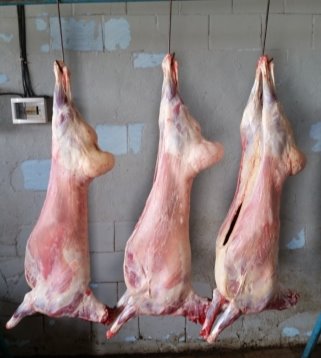This article presents the results of meat productivity assessment of Kazakh fat-tailed coarse wool breed of sheep in the case of «Kaskabulak» LLP of Abay region.
Keywords: meat productivity, lamb, carcass, slaughter yield.
The main goal in the cultivation of sheep of the meat-and-fat direction is the production of young meat with a low cost of carcass and a weight of at least 16–18 kg for slaughter in the year of birth.
Therefore, in meat-and-fat sheep breeding, breeding should be aimed at the precocity of lambs and increasing pasture properties in natural pasture conditions, i.e. meat-and-fat qualities of animals.
Currently, one of the main tasks of this industry is to preserve the breeding qualities of sheep by increasing the number of sheep and proper breeding work [1–2].
The main indicators of sheep meat productivity are: live weight before slaughter, carcass weight, abdominal fat mass, slaughter weight, slaughter yield, sheep fatness category, varietal and morphological composition of carcass, feed value of meat, etc.
The research was carried out in the conditions of the limited liability partnership «Kaskabulak» of the Abay region. Kazakh Kazakh fat-tailed coarse wool breed of sheep were selected for practice, from which 2 groups were selected for research work, depending on the type of constitutional productivity. There were 20 male lambs in each group.
The weight of the carcass is measured after the animal's skin has been removed, the blood has been drained, the internal organs and the head, legs and tail have been removed. The carcass is measured together with the kidneys and kidney fat. The forelimbs are separated from the front knees, the hind ones from the Achilles tendon. After the slaughter of animals, the carcass at that time is called a steamed carcass, and after 24 hours it is cooled, kept in the refrigerator at a temperature of 4–6 ° C. A chilled carcass has less weight than a steamed carcass, because it loses moisture when cooled. Fatter carcasses lose less moisture than skinny ones.
The slaughter weight includes the carcass weight and internal fat (interior fat, scar, intestinal fat). Tail fat is added to the slaughter weight of meat-fat and fat-tailed sheep — tail fat is released during the slaughter of livestock and is weighed individually.
In «Kaskabulak» LLP we conducted a control slaughter (Table 1).
Table 1
Results of control slaughter of 4-month-old lambs (n =3)
|
Indicators |
Constitutional type |
|
|
strong |
dense |
|
|
live weight before slaughter, kg |
33,6 |
30,9 |
|
weight of carcass without tail, kg |
15,1 |
13,6 |
|
carcass yield, % |
44,9 |
44,0 |
|
tail weight, kg |
1,5 |
1,4 |
|
tail yield, % |
4,5 |
4,5 |
|
interior fat weight, kg |
0,12 |
0,14 |
|
Interior fat yield, % |
0,4 |
0,4 |
|
slaughter weight, kg |
16,7 |
15,1 |
|
slaughter yield, % |
49,7 |
48,8 |
As can be seen from Table 1, 4-month-old tailed lambs of a strong and dense constitutional type by live weight showed compliance with the bonitation instructions of the breed of tailed sheep by minimum standard indicators with the basics of breeding work. The carcass of strong type lambs surpassed the carcass of dense type lambs by 2.7 kg. According to the mass of abdominal fat, strong and dense types of lamb carcasses differ greatly from each other. The carcass of strong-type lambs was 0.9 percent higher in slaughter yield (picture 1).

Fig. 1. Carcasses of 4-month-old lambs
In sheep that are specifically oriented in the direction of meat, fat accumulates in individual muscle bellies, which is called the marbling of meat and gives the meat a special tenderness and juiciness.
Meat-greasy sheep breeds have a good ability to accumulate fat, their fat accumulates mainly in the tail area and on the side of the caudal fin.
Fat on the belly of lambs begins to accumulate at an early age, and it depends on the degree of feeding. If the feeding is very good, at the age of three months, lambs accumulate fat in the kidney area, with an average feeding, it accumulates late.
Therefore, the development and cessation of fat collection are closely related to the age, breed and feeding conditions of livestock. It is considered optimal if no more than 25 % of fat accumulates in the carcass at a weight of 16–18 kg, including subcutaneously — 13, intermuscularly — 10 and renal — 2 %. For carcasses with a fat layer thickness of 16–18 kg, it is better to have a long back muscle of 3–3.5 mm, and for carcasses of 20–25 kg — 4–5 mm.
The morphological composition of the carcass depends on the breed, sex, age and adaptability of the sheep. Lamb carcasses contain less meat and fat and more bones than adult cattle. As the number of livestock increases, the fat and meat part increases, and the weight of bones decreases. If the fat formation in the carcasses of cattle of average survival rate is 2 times greater than the fatness below average, then above average-more than 3 times. At the same time, the output of more valuable spinal–pelvic and posterior parts, thoracic parts increases.
Mutton contains up to 53–72 % water, up to 28–47 % dry matter. As the fatness of sheep increases, the amount of dry matter, especially protein and fat, increases. Excess fat content in the carcass becomes not very popular.
The morphological composition of the carcass is characterized by the ratio of its main parts: muscle, adipose tissue, bone. The ratio of these main parts of the carcass creates conditions for its feed value and depends on the breed, age, sex and livestock.
Table 2
Morphological composition of the carcass
|
Indicators |
Constitutional type |
||
|
dense |
strong |
||
|
weight of carcass without tail, kg |
13,6 |
15,1 |
|
|
in it meat |
kg |
11,4 |
11, 4 |
|
% |
75,5 |
75, 5 |
|
|
in it bones |
kg |
3,7 |
3, 7 |
|
% |
25,7 |
24,5 |
|
|
coefficient of meeting |
2,9 |
3,1 |
|
According to Table 2, the carcass of sheep of a strong constitutional type has a higher meat mass compared to the carcass of sheep of a dense constitutional type. The coefficient of meeting is higher in the carcasses of lambs of dense constitutional type compared to the carcass of lambs of dense constitutional type /2,9/ 3,1/.
As a result of the research, we came to the conclusion that compared with the carcasses of lambs of dense constitutional type, the carcasses of lambs of strong constitutional type have a high slaughter yield (49.7 % and 48.8 %) and the meat ratio /3,1 and 2,9/.
Strong-bodied sheep often deposit fat in the tail and reduce the meat ratio. We propose to increase the meat yield and slaughter yield as a result of crossing males of a strong constitutional type with females of a dense constitutional type or females of a strong constitutional type with males of a dense constitutional type.
References:
1. Bukeikhanov A. N. Field in the country sheep economy: monograph. — Almaty: International subscription agency, 2014.- 123 p.
2. Omarkojauly N., Kozhebaev B.Zh. Animal husbandry of industries technology: study tool — Astana, 2014. — 291 p.







